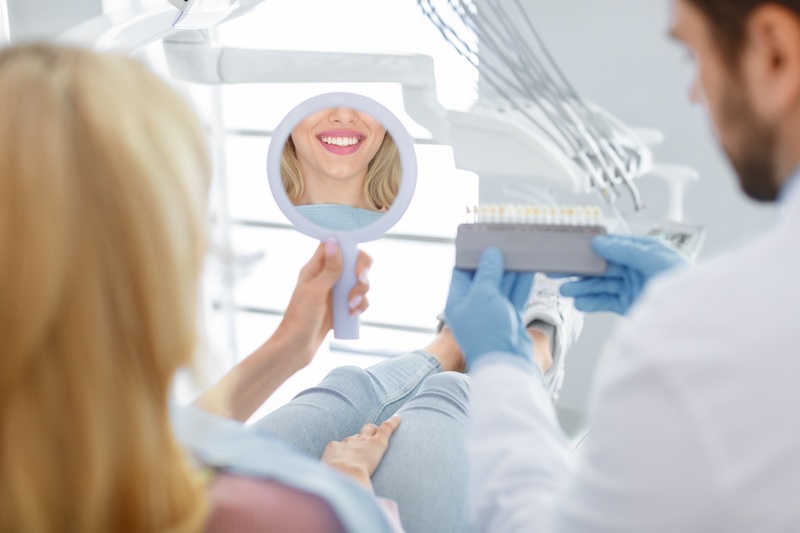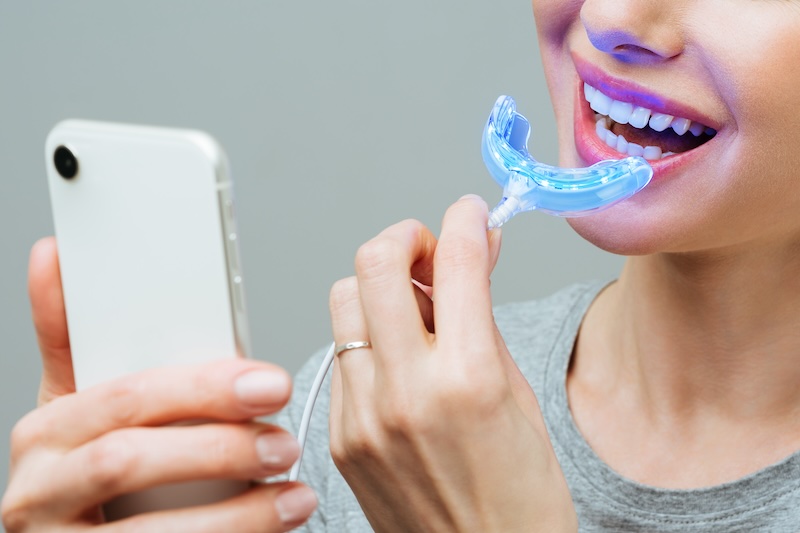Ever wondered why teeth-bleaching methods are the talk of the town? This isn’t just about vanity.
“A smile so bright, it could light up a room”—isn’t this what we all want? But when our pearly whites start to fade, we’re left in the dark. So how do you turn back time on your chompers?
Teeth bleaching might be your beacon of hope. It’s like giving your teeth a new lease on life—but with so many options out there, where do you even start?
Table Of Contents:
- Professional In-Office Whitening Treatments
- At-Home Bleaching Kits from Dental Professionals
- Over-the-Counter Teeth Whitening Products
- Natural and DIY Teeth Whitening Methods
- Risks and Considerations When Choosing a Bleaching Method
- Maintaining Your Bright Smile Post-Bleaching
- FAQs about Teeth Bleaching Methods
Professional In-Office Whitening Treatments
If you’re looking for fast and noticeable results, professional in-office whitening treatments are the way to go. Dentists use high-concentration bleaching agents that aren’t available over the counter, making this method more effective than DIY kits.
Laser Teeth Whitening: A High-Tech Smile Solution
Dentists often recommend laser teeth whitening because it’s quick and efficient. During this procedure, a protective barrier is placed on your gums, followed by the application of a strong bleaching gel. Then, a concentrated beam of light—our trusty laser—activates the gel to lift stains off your teeth rapidly.
This method can make your smile several shades brighter in just one visit. But remember, proper aftercare is crucial to maintain those pearly whites.
Light-Activated Bleaching: Shine Your Way to Brighter Teeth
In contrast to lasers, light-activated bleaching uses LED or halogen lights. Here’s how it works: much like with laser treatments, a potent bleach solution is applied to your teeth first. Next comes the special light source—it doesn’t heat up like lasers but still kicks off an impressive brightening reaction.
The whole process usually wraps up within an hour or so, which means you could get it done during lunch break.
ZOOM.® Whitening: An Express Route to Stain-Free Smiles
ZOOM.® is another popular option at dental offices these days. You might have heard about its rapid effectiveness; a unique hydrogen peroxide formula interacts with UV light for immediate stain removal effects right before your eyes—a favorite for anyone needing speedy results.
Note: No matter which professional treatment you pick, safety should always come first. Be sure to chat with your dentist about what will work best for you—and let them know if there’s any sensitivity afterward so they can help fix things up quickly.
For a quick, dramatic smile upgrade, professional whitening treatments are your best bet. They use powerful bleaching agents and technology like lasers or LED lights to blast away stains fast—think instant results over lunch break. Just talk with your dentist for the safest fit and keep up with aftercare.

At-Home Bleaching Kits from Dental Professionals
Getting that pearly white smile doesn’t always mean sitting in a dentist’s chair. Dentist-prescribed at-home bleaching kits are a convenient alternative, offering professional results from the comfort of your home.
The Edge Over Store-Bought Options
Dental professionals’ kits often contain higher concentrations of whitening agents, like hydrogen peroxide or carbamide peroxide, compared to their over-the-counter counterparts. This means you can achieve noticeable results more quickly and effectively.
Besides potency, these kits come with custom-fitted trays made just for your teeth. A snug fit ensures even coverage and protects your gums from irritation—something one-size-fits-all products can’t promise.
A Tailored Whitening Experience
Your dentist will first evaluate your dental health to make sure you’re a good candidate for bleaching—a step that safeguards against potential complications. They’ll then provide guidance on how long and how often to use the kit based on your unique needs.
This personalized approach helps maximize benefits while minimizing risks such as tooth sensitivity or enamel damage—common concerns when using generic products without professional input.
Maintaining Professional Standards at Home
To get started with an at-home kit, follow instructions meticulously—tooth by tooth if necessary. Your diligence pays off by keeping those stunning results longer without compromising oral health.
You’ll also receive expert advice on post-whitening care which is crucial for maintaining both the brightness of your smile and overall dental well-being.
Remember, following through with routine check-ups allows dentists to monitor progress and tweak treatments as needed for optimal outcomes.
Say goodbye to guesswork, because when it comes down to achieving that bright smile safely and effectively, a professionally guided touch makes all the difference.

Over-the-Counter Teeth Whitening Products
You want a brighter smile and you want it now. You’ll be pleased to find a wide range of OTC teeth whitening items available, offering the potential for you to get your desired brighter smile without having to go see the dentist. But do they deliver? Let’s peel back the layers on these popular options.
Whitening Strips: A Convenient Option
Barely there and easy to use, whitening strips cling to your pearly whites like plastic wrap on leftovers. They contain hydrogen peroxide or carbamide peroxide, which work overtime to break down stains. Apply them while you binge-watch your favorite show, but remember that patience is key to seeing results.
Toothpaste That Packs a Punch
Your daily brushing routine can double as a whitening session with the right toothpaste. Loaded with mild abrasives and chemicals that polish away surface stains, these toothpastes offer gradual brightening. Just don’t expect overnight miracles—consistency is what counts here.
Gels That Get Down To Business
If you need something stronger than strips or paste, gels step up to bat. These bad boys come in trays or pens filled with bleaching agents much like those used by pros—but at lower concentrations. Wear them according to instructions, since too much of a good thing isn’t so great for your gums.
The bottom line? OTC teeth whiteners have their perks—they’re convenient, affordable, and easy to use.
Natural and DIY Teeth Whitening Methods
Ever wondered if your pantry could hold the secret to a brighter smile?
Baking soda has long been praised for its whitening abilities. It’s not just an old wives’ tale; this kitchen staple can remove surface stains on teeth, thanks to its abrasive nature.
Baking Soda and Lemon Juice Paste
Mixing baking soda with lemon juice creates a paste that might help you achieve several shades lighter teeth. But be careful. This combo is potent, so it’s best used sparingly to avoid enamel damage.
Mix a teaspoon of baking soda with enough lemon juice to form a paste for an effective cleaning solution. Apply it once a week at most and always rinse well after use because acidity from lemons can be tough on tooth enamel over time.
Hydrogen Peroxide Rinse
This household disinfectant also doubles as a mouth rinse that may brighten your teeth. A study showed hydrogen peroxide could whiten teeth, but using too strong of a solution might irritate your gums or harm your teeth, so stick with low concentrations and short contact times.
Turmeric Powder Scrub
You’d think turmeric would stain everything yellow, right? Surprisingly, this spice works wonders when brushed onto the pearly whites. Although evidence is anecdotal rather than scientific here—many swear by it for removing plaque buildup without harsh chemicals involved.
Just sprinkle some powder on your brush or make it into a paste with water before scrubbing gently onto your chompers twice monthly at most.P.S.: Have floss handy—it gets between the gaps.
Risks and Considerations When Choosing a Bleaching Method
When it comes to teeth bleaching, not all that glitters is gold. There are several risks you need to be aware of before seeking that pearly white smile. While professional treatments often provide the most dramatic results, they can also lead to tooth sensitivity or gum irritation if not done correctly.
Potential Side Effects of Teeth Whitening
The pursuit of whiter teeth can sometimes lead down a path lined with side effects. Common ones include increased tooth sensitivity and mild gum irritation. More rarely, some people experience severe tooth damage from overuse of whitening products or improper application techniques.
If you have dental restorations like crowns or veneers, remember that these will not bleach like your natural teeth. This mismatch could leave you with uneven coloring post-treatment—a consideration worth weighing in advance.
Navigating At-Home Treatments Safely
Diving into at-home whitening kits without proper guidance is like navigating without a map; you might get lost along the way. Over-the-counter options vary widely in strength and effectiveness but using them too frequently can wear down enamel over time—so moderation is key.
To safeguard your oral health while using home kits, follow instructions meticulously and look out for FDA-approved labels. They’re there for a reason—to let you know what’s safe for use on those precious chompers.
Selecting The Right Product For You
Finding the right bleaching method means considering both safety profiles and personal needs. You should always consult with your dentist first, especially if dealing with sensitive teeth or pre-existing dental issues—they’ll point you towards solutions tailored just for your grin.
Bleach isn’t one-size-fits-all; think about how different fabrics react differently to bleach when selecting a product—that’s how varied our teeth are too. Always opt for quality over quick fixes because nothing beats long-term wellness when it comes to dental care.
Before bleaching your teeth, be aware of the risks like sensitivity and gum irritation. Not all products work on restorations, uneven coloring can happen.
Use at-home kits with care; follow instructions and check for FDA approval to protect your enamel. Your dentist knows best—get their advice to find a safe, effective method tailored to you.
Maintaining Your Bright Smile Post-Bleaching
So, you’ve got that dazzling smile after a teeth-bleaching session. Keeping it bright is the next big step.
Dietary Adjustments for Lasting Whiteness
Your diet plays a huge part in maintaining your new pearly whites. It’s best to avoid or limit foods and drinks known to stain teeth—think coffee, red wine, and soy sauce. But don’t worry; this doesn’t mean you can never enjoy your favorites again. Just remember moderation is key.
Sipping darker liquids through a straw can help by reducing direct contact with your teeth. And always rinse with water after enjoying these treats to lessen their staining power. Learn more about how what you eat affects oral health here.
Routine Oral Hygiene Practices
Daily brushing and flossing are non-negotiables, but there’s more you can do post-bleaching to keep stains at bay. Swap out your toothbrush every three months—or sooner if the bristles fray—to make sure it’s cleaning effectively.
Incorporate an alcohol-free whitening mouthwash into your routine too—it’ll not only freshen your breath but also fight potential discoloration. Check out ADA recommendations on choosing the right mouthwash.
The Role of Regular Dental Visits
Last but not least, regular dental check-ups are vital for keeping that gleam going strong. A professional cleaning every six months removes plaque build-up that home care might miss, helping prevent dullness from creeping back in.
Your dentist can also give personalized advice tailored just for you—and spot any issues early on before they become major problems.
To place your dental health in the best position, nothing can replace dental insurance. At Goldstein Healthcare we can not only get you the perfect plan (we work with all major providers), but we can help with vision insurance, insurance for individuals and families, and so much more. Contact us today to get started.
FAQs about Teeth Bleaching Methods
What is the most effective method of teeth whitening?
Dentist-supervised bleaching often yields the fastest and most dramatic results, thanks to high-concentration peroxide agents.
What is the best bleaching for teeth?
The “best” varies by individual needs but professional in-office treatments typically top effectiveness charts.
What are the different types of teeth bleaching?
You’ve got in-office whitenings, at-home kits from dentists, over-the-counter products, and natural DIY remedies on your list.
How does a dentist bleach teeth?
A dentist applies a strong peroxide solution and may use light or heat to speed up the process safely.

